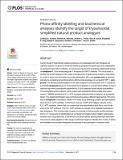Photo-affinity labelling and biochemical analyses identify the target of trypanocidal simplified natural product analogues
Abstract
Current drugs to treat African sleeping sickness are inadequate and new therapies are urgently required. As part of a medicinal chemistry programme based upon the simplification of acetogenin-type ether scaffolds, we previously reported the promising trypanocidal activity of compound 1 , a bis-tetrahydropyran 1,4-triazole (B-THP-T) inhibitor. This study aims to identify the protein target(s) of this class of compound in Trypanosoma brucei to understand its mode of action and aid further structural optimisation. We used compound 3 , a diazirine- and alkyne-containing bi-functional photo-affinity probe analogue of our lead B-THP-T, compound 1 , to identify potential targets of our lead compound in the procyclic form T. brucei. Bi-functional compound 3 was UV cross-linked to its target(s) in vivo and biotin affinity or Cy5.5 reporter tags were subsequently appended by Cu(II)-catalysed azide-alkyne cycloaddition. The biotinylated protein adducts were isolated with streptavidin affinity beads and subsequent LC-MSMS identified the FoF1-ATP synthase (mitochondrial complex V) as a potential target. This target identification was confirmed using various different approaches. We show that (i) compound 1 decreases cellular ATP levels (ii) by inhibiting oxidative phosphorylation (iii) at the FoF1-ATP synthase. Furthermore, the use of GFP-PTP-tagged subunits of the FoF1-ATP synthase, shows that our compounds bind specifically to both the α- and β-subunits of the ATP synthase. The FoF1-ATP synthase is a target of our simplified acetogenin-type analogues. This mitochondrial complex is essential in both procyclic and bloodstream forms of T. brucei and its identification as our target will enable further inhibitor optimisation towards future drug discovery. Furthermore, the photo-affinity labeling technique described here can be readily applied to other drugs of unknown targets to identify their modes of action and facilitate more broadly therapeutic drug design in any pathogen or disease model.
Citation
Tulloch , L B , Menzies , S K , Fraser , A L , Gould , E R , King , E F , Zacharova , M K , Florence , G J & Smith , T K 2017 , ' Photo-affinity labelling and biochemical analyses identify the target of trypanocidal simplified natural product analogues ' , PLoS Neglected Tropical Diseases , vol. 11 , no. 9 , e0005886 . https://doi.org/10.1371/journal.pntd.0005886
Publication
PLoS Neglected Tropical Diseases
Status
Peer reviewed
ISSN
1935-2735Type
Journal article
Description
This work was supported by the Leverhulme Trust (Grant number RL2012-025). The funders had no role in study design, data collection and analysis, decision to publish, or preparation of the manuscript.Collections
Items in the St Andrews Research Repository are protected by copyright, with all rights reserved, unless otherwise indicated.

